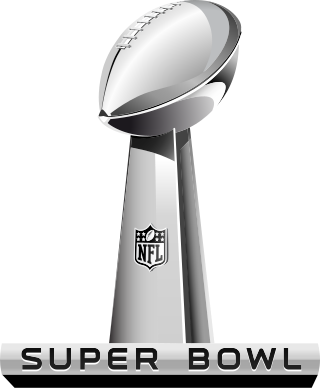
The Super Bowl is the annual league championship game of the National Football League (NFL) of the United States. It has served as the final game of every NFL season since 1966, replacing the NFL Championship Game. Since 2022, the game is played on the second Sunday in February. Prior Super Bowls were played on Sundays in early to mid-January from 1967 to 1978, late January from 1979 to 2003, and the first Sunday of February from 2004 to 2021. Winning teams are awarded the Vince Lombardi Trophy, named after the eponymous coach who won the first two Super Bowls. Because the NFL restricts use of its "Super Bowl" trademark, it is frequently referred to as the "big game" or other generic terms by non-sponsoring corporations. The day the game is played is often referred to as "Super Bowl Sunday" or simply "Super Sunday".

Candlestick Park was an outdoor stadium on the West Coast of the United States, located in San Francisco's Hunters Point area. The stadium was originally the home of Major League Baseball's San Francisco Giants, who played there from 1960 until 1999, after which the Giants moved into Pacific Bell Park in 2000. It was also the home field of the San Francisco 49ers of the National Football League from 1971 through 2013. The 49ers moved to Levi's Stadium in Santa Clara for the 2014 season. The last event held at Candlestick was a concert by Paul McCartney in August 2014, and the demolition of the stadium was completed in September 2015. As of 2019, the site is planned to be redeveloped into office space.
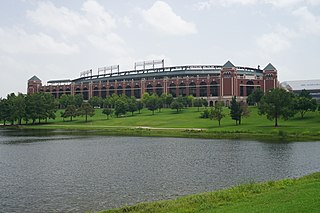
Choctaw Stadium, formerly Globe Life Park, is an American multi-purpose stadium in Arlington, Texas, United States. The venue opened in April 1994 as a baseball stadium with the name The Ballpark in Arlington, serving as the home for the Texas Rangers of Major League Baseball from 1994 through 2019. It replaced the nearby Arlington Stadium, and was succeeded by Globe Life Field.
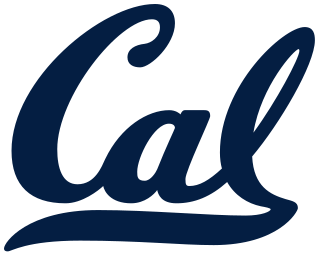
Big Game is the name given to the California–Stanford football rivalry. It is an American college football rivalry game played by the California Golden Bears football team of the University of California, Berkeley, and the Stanford Cardinal football team of Stanford University. Both institutions are located in the San Francisco Bay Area. First played in 1892, it is one of the oldest college rivalries in the United States. The game is typically played in late November or early December, and its location alternates between the two universities every year. In even-numbered years, the game is played at Berkeley, while in odd-numbered years it is played at Stanford.

Texas Stadium was an American football stadium located in Irving, Texas, a suburb west of Dallas. Opened on October 24, 1971, it was known for its distinctive hole in the roof, the result of abandoned plans to construct a retractable roof.

Kezar Stadium is an outdoor athletics stadium in San Francisco, California, located adjacent to Kezar Pavilion in the southeastern corner of Golden Gate Park. It is the former home of the San Francisco 49ers and the Oakland Raiders of the National Football League (NFL) and of the San Francisco Dragons of Major League Lacrosse. It serves as the home of San Francisco City FC of USL League Two.
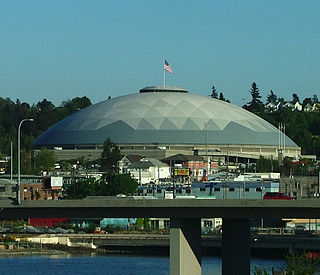
Tacoma Dome is an indoor multi-purpose arena in Tacoma, Washington, United States. It is located south of Downtown Tacoma, adjacent to Interstate 5 and Tacoma Dome Station. It is currently used for basketball tournaments by the Washington Interscholastic Activities Association (WIAA), concerts, and other community events. In its early years, it was primarily used as a venue for minor league ice hockey and indoor soccer, and later temporarily hosted professional teams from Seattle.

BC Place is a multi-purpose stadium in Vancouver, British Columbia, Canada. Located at the north side of False Creek, it is owned and operated by the BC Pavilion Corporation (PavCo), a crown corporation of the province.
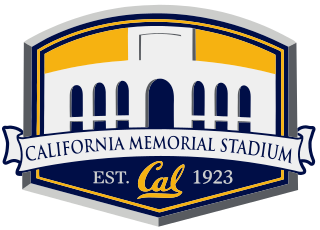
California Memorial Stadium also known simply and commonly as Memorial Stadium is an outdoor college football stadium on the west coast of the United States, located on the campus of the University of California in Berkeley, California. It is the home field for the California Golden Bears of the Atlantic Coast Conference.
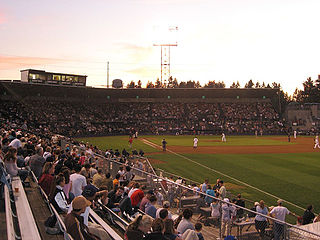
Cheney Stadium is a multi-purpose stadium located in Tacoma, Washington, United States. It is primarily used for baseball and is home to the Tacoma Rainiers of the minor league Pacific Coast League. The stadium also hosted professional soccer teams, including the Tacoma Defiance of the USL Championship until 2022 and OL Reign of the National Women's Soccer League until 2021. Cheney Stadium opened in 1960 and has a capacity of 6,500 seats. It is next to Henry Foss High School, and the stadium has an agreement with the school to use the school parking lot for parking.

Stanford Stadium is an outdoor college football stadium on the west coast of the United States, located on the campus of Stanford University in Stanford, California. It is the home of the Stanford Cardinal and hosts the university's commencement exercises. Opened 103 years ago in 1921 as a football and track and field stadium, it was an earthen horseshoe with wooden bleacher seating and flooring upon a steel frame. Its original seating capacity was 60,000, which grew to 89,000 by 1927 as a nearly enclosed bowl.

Smokies Stadium is a baseball stadium located in Kodak, Tennessee, just north of Sevierville and east of Knoxville, adjacent to the tourist centers of Pigeon Forge and Gatlinburg. The park, which opened in 2000, has a capacity of 6,412. It is the home of the Tennessee Smokies of the Southern League. Smokies Park was constructed as a replacement facility for the since shuttered Bill Meyer Stadium in Knoxville.

The Conservatory of Flowers is a greenhouse and botanical garden that houses a collection of rare and exotic plants in Golden Gate Park, San Francisco, California. With construction having been completed in 1879, it is the oldest building in the park. It was one of the first municipal conservatories constructed in the United States and is the oldest remaining municipal wooden conservatory in the country. For these distinctions and for its associated historical, architectural, and engineering merits, the Conservatory of Flowers is listed on the National Register of Historic Places and the California Register of Historical Places. It is a California Historical Landmark and a San Francisco Designated Landmark.
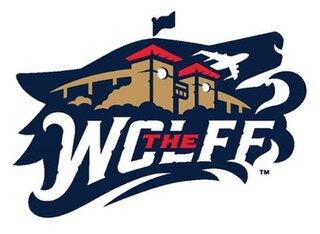
Nelson W. Wolff Municipal Stadium is a stadium in San Antonio, Texas, United States. It is primarily used for baseball, and is the home field of the San Antonio Missions Minor League Baseball team of the Texas League. The UTSA Roadrunners baseball team also plays some home games at the stadium. The stadium is named for Bexar County Judge Nelson Wolff, who is a former Texas legislator and San Antonio councilman and mayor.

The California Golden Bears (Cal) football program represents the University of California, Berkeley in college football as a member of the Pac-12 Conference at the NCAA Division I FBS level. The team plays its home games at California Memorial Stadium and is coached by Justin Wilcox. Since beginning of play in 1886, the team has won five NCAA recognized national titles - 1920, 1921, 1922, 1923, and 1937 and 14 conference championships, the last one in 2006. It has also produced what are considered to be two of the oddest and most memorable plays in college football: Roy "Wrong Way" Riegels' fumble recovery at the 1929 Rose Bowl and The Play kickoff return in the 1982 Big Game.

Levi's Stadium is an American football stadium located in Santa Clara, California, just west of the much larger city of San Jose, in the San Francisco Bay Area. It has served as the home venue for the National Football League (NFL)'s San Francisco 49ers since 2014. The stadium is located approximately 40 miles (64 km) south of San Francisco. It is named after Levi Strauss & Co., which purchased naming rights in 2013.
The 1924 Stanford football team represented Stanford University as a member of the Pacific Coast Conference (PCC) during 1924 college football season. Led by first-year head coach was Pop Warner, Stanford compiled an overall record of 7–1–1 with a mark of 3–0–1 in conference play, winning the program's first PCC title. Stanford made its second bowl game appearance, losing to Notre Dame in the Rose Bowl].
The 1900 Stanford Cardinal football team represented Stanford University in the 1900 college football season. In their first and only season under head coach Fielding H. Yost, the team compiled a 7–2 record, shut out seven of nine opponents, scored 154 points, and allowed 20 points by opponents. The team registered three shutouts against the Reliance Club, two shutouts against California State Normal School, now known as San Jose State University, and single game shutouts against Oregon and California. The team's two losses came against Nevada (0–6) and a Stanford alumni team (0–14) that featured coach Yost playing at the fullback position.
The 1921 Stanford football team represented Stanford University in the 1921 college football season. They were coached by Eugene Van Gent in his only season as head coach. The team played most of its home games at the 15,000-seat Stanford Field while construction on the new 60,000-seat Stanford Stadium was being completed. Stanford Stadium officially opened for the final game, the Big Game against California, in which the Bears defeated Stanford 42–7.
The 1922 Stanford football team represented Stanford University as a member of the Pacific Coast Conference (PCC) during the 1922 college football season. Led by first-year head coach Andrew Kerr, Stanford compiled an overall record of 4–5 with a mark of 1–3 in conference play, tying for fifth place in the PCC. For the first time, the team played all its home games at Stanford Stadium, the construction of which had been completed at the end of the previous season. With imminent construction of California Memorial Stadium in Berkley, California, Stanford hosted the Big Game for the second straight year, the only time the game was played in successive seasons at Stanford Stadium.















